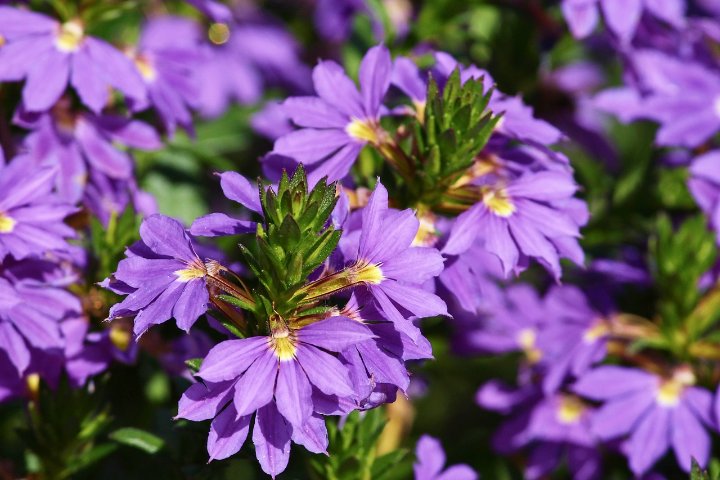Scaevola, commonly known as the fan flower, is a delightful addition to any garden with its unique fan-shaped blooms and trailing growth habit. This easy-to-grow plant adds a touch of elegance and charm to flower beds, hanging baskets, and containers. Here’s everything you need to know about growing and caring for Scaevola.
Best Scaevola Varieties
| Image | Name | Rating | Shop |
|---|---|---|---|
 | Scaevola Flower Seeds |  | |
 | Purple Scaevola Flower Seeds |  |
Scaevola Hardiness Zones
Scaevola thrives in warmer climates and is typically hardy in USDA zones 10 to 11. These regions provide the ideal conditions for Scaevola to flourish, with mild winters and long periods of warm weather. While Scaevola may not tolerate freezing temperatures, it can be grown as an annual in cooler climates or overwintered indoors.
How Much Sun Do Scaevola Need
For optimal growth and blooming, Scaevola prefers full to partial sun. Plant them in a location where they can receive at least six hours of sunlight each day. While Scaevola can tolerate some shade, too much shade may result in reduced flowering and leggy growth. Choose a sunny spot in your garden or balcony where Scaevola can bask in the sun’s rays and thrive.
Scaevola Soil Requirements
Scaevola thrives in average, well-drained soil with a slightly acidic pH ranging from 5.5 to 6.0. Ensure the soil is loose and friable, allowing for proper root development and water penetration. Amending heavy or compacted soil with organic matter such as compost or peat moss can improve soil texture and drainage, creating an ideal growing environment for Scaevola.
Scaevola Plant Spacing
When planting Scaevola, space the plants approximately 9 to 18 inches apart, allowing room for their trailing growth habit to spread. Scaevola plants typically reach heights of 1 to 2 feet and can spread up to 2 feet wide, creating a lush carpet of foliage and flowers. Proper spacing ensures adequate airflow and prevents overcrowding, promoting healthier growth and fewer disease issues.
Scaevola Water Requirements
While Scaevola prefers dry climates and is somewhat drought-tolerant once established, it still requires regular watering, especially during periods of prolonged dryness. Water the plants deeply but infrequently, allowing the soil to dry out slightly between waterings to prevent waterlogging and root rot. Avoid overhead watering, as wet foliage can promote fungal diseases.
Scaevola Temperature Requirements
Scaevola thrives in warm to hot weather conditions, making it an excellent choice for gardens in tropical and subtropical regions. These heat-loving plants are perfect for adding color to summer landscapes, with their blooms enduring even during the hottest months. Ensure they are protected from cold drafts or frost, as Scaevola may suffer damage in temperatures below 50°F.
Scaevola Humidity Requirements
While Scaevola prefers dry climates, it can adapt to high humidity levels, making it suitable for gardens in both arid and humid regions. In areas with high humidity, provide adequate airflow around the plants to prevent moisture buildup and minimize the risk of fungal diseases. Proper spacing and good air circulation can help maintain optimal growing conditions for Scaevola.
Scaevola Fertilizer Requirements
Scaevola is considered a light feeder and typically does not require heavy fertilization. Apply a balanced, slow-release fertilizer sparingly in spring to provide essential nutrients for healthy growth and blooming. Avoid over-fertilizing, as excessive nitrogen can lead to lush foliage at the expense of flowers. A light feeding once or twice during the growing season is usually sufficient to support Scaevola’s growth and flowering.
Scaevola Pests
Scaevola is relatively pest-resistant and experiences minimal problems with insects. However, occasional pests such as aphids or spider mites may appear, especially in warm, dry conditions. Monitor the plants regularly for signs of pest infestation, and treat affected areas promptly with insecticidal soap or neem oil to control the pests.
Scaevola Diseases
Scaevola is generally resistant to most diseases when grown in well-drained soil with proper airflow and watering practices. However, in humid conditions, fungal diseases such as powdery mildew or leaf spot may occur. To prevent disease issues, avoid overhead watering, provide adequate spacing between plants, and ensure good air circulation. Remove any diseased foliage promptly and apply fungicidal treatments as needed to protect your Scaevola plants.
By following these guidelines and providing proper care, you can enjoy the beauty of Scaevola in your garden or landscape. With its charming fan-shaped flowers and trailing growth habit, Scaevola adds a touch of elegance and color to any outdoor space, making it a favorite among gardeners and landscapers alike.















